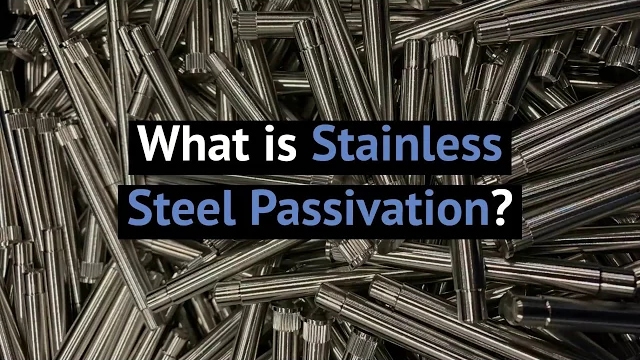Corrosion resistance is critical for metal used in a variety of applications where contamination may have a destructive impact during production or during a product’s end use. Though raw stainless steel begins with a high level of corrosion resistance, surface contamination from grease and oil, debris, and chemicals are usually present on parts and components after machining. The passivation process clears away these contaminants with the goal of enhancing the corrosion resistance of metal components.
What is Stainless Steel Passivation?
Passivation is a non-electrolytic finishing process used to improve the corrosion and rust resistance of stainless steel components after manufacturing. The composition of stainless steel includes iron, chromium and an assortment of other non-ferrous metals, depending on the specific alloy.
Rust requires the presence of iron, so the removal of iron molecules from the metal’s surface creates a preponderance of chromium molecules, which are naturally inert. This majority presence of chromium molecules creates a thick, non-relative, and passive surface on which rust cannot easily form.
Passivation Processes
Stainless steel alloys typically begin with good levels of corrosion resistance, the level of which varies depending upon their molecular makeup. To further improve this resistance, there are three steps involved in passivation:
Step 1. Component Cleaning
The passivation process begins with a thorough cleaning of the stainless steel component, removing any surface oils, chemicals, or debris left over from machining. Without this step of the process, foreign objects on the surface of the metal will limit the effectiveness of passivation.
Step 2. Acid Bath Immersion
Immersion of the component in an acid bath follows cleaning in order to remove any free iron particles from its surface. There are three common approaches used in this step of the process.
Nitric Acid Bath
Nitric acid is the traditional approach to passivation, producing the most effective molecular redistribution of the molecular structure of the metal’s surface. However, nitric acid has some drawbacks due to its classification as a hazardous material. It not only requires special handling, but it emits toxic gases, is hazardous to the environment, and can require longer processing time.
Nitric Acid with Sodium Dichromate Bath
With some specific alloys, the addition of sodium dichromate to nitric acid enhances or speeds up the passivation process. Sodium dichromate intensifies the hazards of nitric acid bathing, so it is a less common option.
Citric Acid Bath
A safer alternative to nitric acid passivation uses citric acid. Citric acid does not require special handling, does not emit any toxic gases, and is an environmentally friendly option. Citric acid passivation was struggled to gain popularity because its compounds risked organic growth and molds, but innovations in recent years have eliminated these problems, making it a cost-effective and eco-friendly alternative.
Regardless of the applied approach, this dipping or bathing process produces a chemical reaction on the surfaces of the component, adding a thin layer of oxide film with little-to-no iron molecule presence, restoring the metal’s corrosion resistance to its raw material state.
Step 3. Testing and Certification
Testing after the passivation process provides verification of the effectiveness of the passivation process and certifies compliance with ASTM, Mil-Spec, and other various industry standards.
Benefits and Applications
There are multiple benefits derived from passivation, including:
- Removal of leftover contaminants after machining
- Increased corrosion resistance
- Reduced risk of contamination during production processes
- Enhanced component performance
- Increased term between maintenance intervals
These passivation benefits are universal in a wide range of industries across numerous applications which rely on the non-corrosive properties of stainless steel, including:
- Heavy equipment (ball bearings, fasteners)
- Aerospace and aircraft components
- Medical (orthopedic implants, surgical instruments)
- Pharmaceutical (pumps, fittings, and components used in manufacturing)
- Military (firearms, military equipment)
- Energy (power distribution and transmission)

Stainless Steel Passivation from FZE Manufacturing
Rust and other types of corrosion on stainless steel surfaces can produce destructive results over time. The process of passivation removes the threat of corrosive contamination by restoring the resistive properties of machined components to the raw material state of their specific alloy.
Contact us to learn more about stainless steel passivation services from FZE Manufacturing Solutions or request a quote for your organization’s specific needs.
